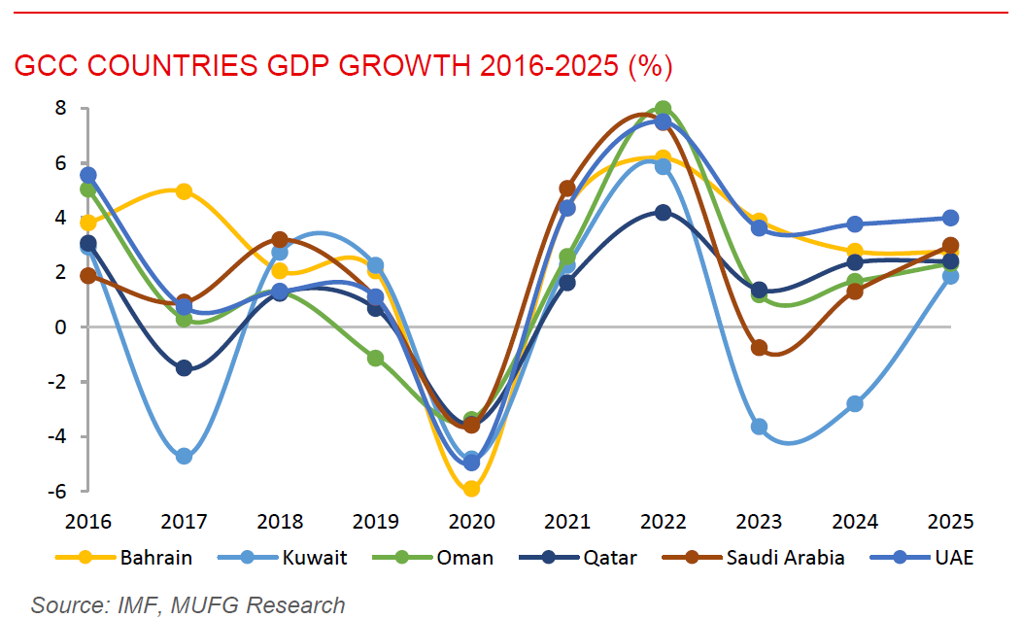To read the full report, please download the PDF above.
Middle East Daily
SOOJIN KIM
Research Analyst
DIFC Branch – Dubai
T: +44(4)387 5031
E: soojin.kim@ae.mufg.jp
MUFG Bank, Ltd. and MUFG Securities plc
A member of MUFG, a global financial group
Middle East Daily
COMMODITIES / ENERGY
Oil steadies as markets awaits US-Russia talks and DOE oversupply revision. Oil prices stabilised after yesterday’s decline, with Brent holding just above USD66/b and WTI near USD63/b as markets awaited the outcome of Friday’s planned meeting between US President Trump and Russia President Putin. While US Secretary of State Marco Rubio and Russia’s Sergei Lavrov prepared for the summit, expectations for a breakthrough in the Ukraine conflict remained low, especially as Ukraine reiterated it would not cede the Donbas region, a key Russian demand for a ceasefire. Traders are watching closely for any sign that US sanctions on Russia could be eased, potentially unlocking additional supply from the OPEC+ producer. The US Department of Energy raised its forecast for this year’s global oil surplus to 1.7mb/d, contrasting with OPEC’s more bullish view of a tighter market in 2025. Market activity was muted, with Brent trading volumes below average and implied volatility near a two-week low, as investors also awaited official US inventory data after industry figures showed a slight rise in stockpile.
Gold steadies as inflation fuels Fed cut bets. Gold held steady after a 0.2% gain in the previous session as a US inflation report met expectations, reinforcing bets on a Fed rate cut next month. While core inflation rose to its highest level since early 2025, a subdued increase in goods prices eased concerns over tariff-driven pressures. The softer labour market backdrop strengthened expectations for policy easing, which typically benefits non-yielding assets like gold. Traders are still awaiting clarity on whether gold bar imports will face tariffs, after conflicting messages from President Trump. Gold has risen about 23% this year, mostly in the first four months, supported by geopolitical and trade tensions and strong central bank buying.
MIDDLE EAST - CREDIT TRADING
End of day comment – 12 August 2025. Market valuations remain stretched, with JPEIGLSP Index at levels seen only twice since 2013 and EMUOAS Index at all-time tights, prompting the question of just how expensive conditions are—comparable to a “solid C” on a humorous scale ranging from minor budget trimming to catastrophic financial overreach. Investment-grade names are driving these tight levels, while EM high-yield spreads are still 30bps off historic lows and US high-yield 60bps away. While not cheap, high yield (both EM and US) could be seen as relatively inexpensive compared to IG in a compressed valuation environment. IG is expected to outperform HY in periods of volatility, particularly if the cause is US-driven, and there is also an argument for EM IG to trade tight to the US. In KSA, the post-CPI rates head fake prompted minimal reaction beyond small indicative cash price dips; short end widened with rates, while mid- and long-end KSA tightened a few bps. Trades included $10mm ALMARA and USD10mm ALINMA between local and western accounts, with PIFKSA 3–4bps tighter. Turkish corporates and senior financials continued compressing significantly to the sovereign, with real money topping up retail positions and some trades clearing above the CBBT offered side.
MIDDLE EAST - MACRO / MARKETS
Turkey’s current account deficit widens in June amid strong FDI inflows. Turkey’s current account balance swung to a USD2.01bn deficit in June 2025, reversing a USD0.83bn surplus in the same month last year, according to Central Bank of Turkey (CBRT). The shortfall was driven by a wider goods trade deficit of USD6.48bn and a larger primary income deficit of USD1.45bn, partly offset by a USD5.99bn surplus in services. Over the first half of 2025, the cumulative deficit reached USD23.1bn, though the balance excluding gold and energy posted a USD2.6bn surplus, signalling resilience in non-energy trade. Foreign direct investment remained robust, with USD616 million in June bringing total H1 inflows to USD6.3bn and USD13.1bn on a 12-month basis, helping to finance the external gap. Despite persistent imbalances, solid FDI and a healthier non-energy trade surplus offer some support to Turkey’s external position.
Bahrain’s economy records steady Q1 2025 growth on non-oil strength. Bahrain’s real GDP expanded by 2.7% y/y in Q1 2025, driven by a 2.2% rise in non-oil activities and a robust 5.3% increase in the oil sector, according to official data. The non-oil economy remained dominant, contributing 84.8% to real GDP, supported by strong performances in accommodation and food services, financial and insurance activities, and construction. Foreign direct investment stock climbed 3.5% to BHD17.1bn (USD45.3bn), reflecting sustained investor confidence. Inflation remained muted at 0.1%, aided by proactive government measures to curb global supply chain pressures. Bahrain’s growth trajectory is in line with GCC peers, with the IMF forecasting regional GDP to reach 3.0% in 2025 and 4.1% in 2026, signalling a positive outlook.

